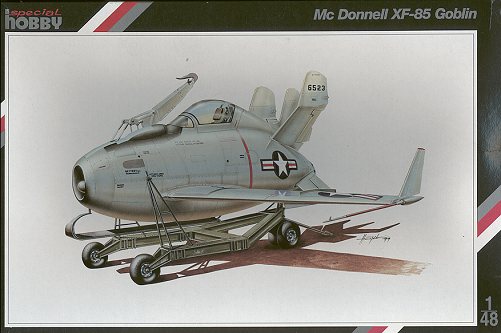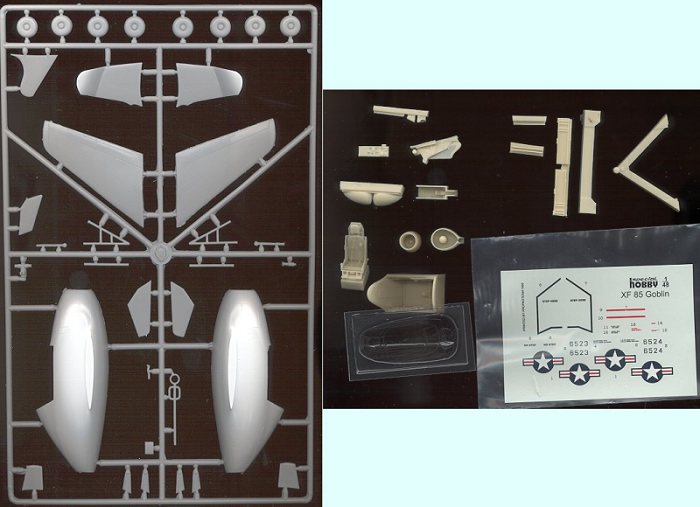
| KIT: | Special Hobby 1/48 XF-85 'Goblin' |
| KIT # | 48003 |
| PRICE: | $17.98 MSRP |
| DECALS: | For both aircraft |
| REVIEW & | |
| NOTES: | Limited run, multi-media kit |

| HISTORY |
During WW2, one of the concerns of the USAAF wasthat of escorting it's bomber fleet to the target and back. While this problemwas allayed in Europe by the Mustang, it was in the Pacific theater where thehuge distances were a real problem for fighter escort. Not until very late inthe war and the taking of Iwo Jima, was it possible to escort the B-29s to theirtarget.
Post war and the distances to the new enemy, theSoviet Union, being even greater, the problem was magnified. The superbomber,the B-36, had tremendous range, however, except for the F-82 Twin Mustang, therewas little that was able to effectively escort the huge aircraft.
With the changeover to jet aircraft, the F-82would have been hopelessly outclassed and there was no way the fuel-thirsty jetsof the time could have been able to escort the B-36 on any missions. It is inthis climate, that the thought of a parasite fighter was tried.
This concept wasn't new, in fact, the Russiansthemselves had successfully used a TB-2 bomber carrying I-16 fighters on severalmissions in the Crimea during WW2. However those were bombing missions by theI-16s with the TB-2 carrying them close to their targets and not true escorts,though that is how the whole program was initially conceived.
In the US, the problem was one of having theaircraft small enough to fit into the bomb bay of the B-36. Then, when attackingfighters approached, the escort would be air launched to fend them off and thenreturn to the B-36 for refueling and rearming for another mission.
The result of this concept was the diminutiveXF-85 'Goblin'. The aircraft was basically built around the size of the engineand had to fit in a B-36 bomb bay. Despite these challenges, two prototypeaircraft were built. The were short, a bit tall, and had folding wings to fitinto the bomb bay. Not having to land, no landing gear were needed. A large hookwas developed for the aircraft to grab a 'trapeze' hung from the mother ship.This is similar to the successful F9C Sparrowhawk fighters that were used forthe Navy's airships Akron and Macon in the '30s.
Using a B-29 mothership, the two prototypesunderwent flight testing in mid-1948. Despite several successful releases andengagements, as well as some that were potentially fatal, the program was notdeemed a success and was terminated in early 1949. Even using the most skilledpilots, the aircraft hookup procedure was quite difficult and it was realizedthat the average USAF pilot would not have the skills needed.
The two XF-85s flew a total of 2 hours 19minutes. At least one is still extant at the USAF Museum in Dayton, Ohio. It is,ironically parked right next to a B-36, the aircraft it was designed for,but never flew from.
| THE KIT |

Special Hobby's XF-85 is typical of what we havecome to expect from Czech short run kits. There is one large sprue of light greyplastic containing the styrene parts of the kit. In a bag are the resin partsand in another is a decal sheet. The canopy is thick vacuformed plastic.
Molding on the styrene parts is good, though theedges of almost all the parts are quite ragged and will require a swipe withsandpaper before using. There are only four ejector pin marks and they are onthe inside of the fuselage halves. Detailing is typically superb, with fineengraved panel lines. You may want to rescribe them a bit deeper beforeconstruction as any filling and sanding will undoubtedly make them disappear.
The resin parts are equally well detailed andappear to be totally free of air bubbles. Most of the resin bits are for theinterior, the hook well, intake, exhaust, and the main frame of the groundhandling trolley. There is also a very well done ejector seat for this aircraft.All parts have some sort of block that needs sanded off, but this is typical ofresin parts and should be no problem for most builders.
The decal sheet is very well done, includesserials for both aircraft, and spot on in terms of registration. Typically it isby Propagteam so much care is needed when applying them as they are tissue thinand will stick like limpets. All the small placards are very well done and caneasily be read. A very clear and properly thick vacuform canopy is alsoincluded. Again, I put forward my plea to add a second canopy for those of uswho invariably screw one up. It cannot be that expensive to produce.
Instructions are an 8 page affair in black andwhite. The first page is a small history in four languages. The second a partsbreakdown and explanation of the various colors and warnings. The next fourpages are a six step construction sequence. After reading, it becomes obviousthat there is great deal more scratchbuilding to do with this kit than manyothers. The pitot tubes, the smaller trolley braces, and all the underfuselageskids must be made by the builder. The size of these items are given (inmillimeters) and does not appear to be too difficult, though one does need someplastic card to properly do the skids. The final two pages are for decalplacement and painting. Other than serial numbers, the schemes are the same.Both are natural metal with yellow fin tips and black anti-glare panel.
I must admit to some initial reservation when I realizedthat I would have to use modeling skills (oh horrors!!), to build this. I alsocame to the realization that anyone who buys a kit like this should already havethem.
The real difference between the kits in in thearea of the landing skid arrangements. The later aircraft has the arrangement asshown on the box art. The other aircraft has a seemingly simpler arrangementwith a nose bump and wing skids (that the second prototype doesn't have). Thekit is designed to be shown on the trolley with the hook extended. Those wishingto display it with the hook retracted may have to fabricate the hook well doorsas they are molded on the back of the resin hook. If you go that route, be awarethat the hook itself will intrude slightly into the engine intake area.
| CONCLUSIONS |
While this is not a kit for the bare beginner,those with minimal scratchbuilding skills will have no problems with it. I amvery much looking forward to starting this kit as the Goblin has alwaysfascinated me. This is the first release of this aircraft in my current scale ofchoice, 1/48, and it will look great in any collection of early jet aircraft.
My thanks go to SquadronMail-Order for providing this kit.